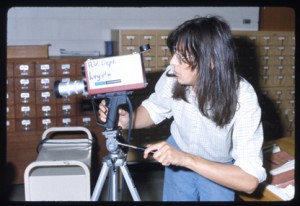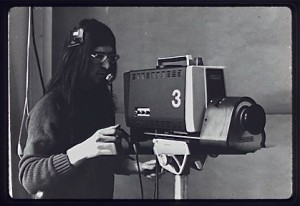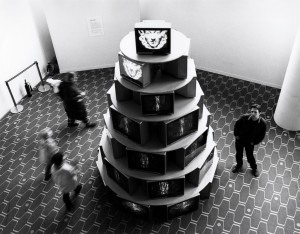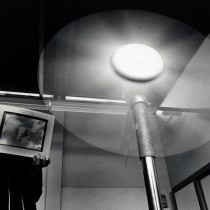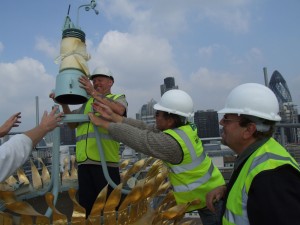Background and Activities
I first encountered video whilst working as an audio-visual technician at the Instructional Materials Centre of the Montreal School Board in 1972. I was immediately captivated by the instant playback and the combination of sound and image. This new medium seemed to offer the ideal blend of photography, film and audio, the mediums that I had been fascinated with since a teenager. Inspired by the film work of Norman Mclaren and other animators at the National Film Board and by the multi-screen projections and large-scale cinematic installations I had experienced at Expo 67, I aspired to work as a film-maker. During this early period I was fortunate to have had the opportunity to meet and work with my first mentor, the special effects expert Wally Gentleman (1926-2001). My early film and photographic knowledge and my affinity with tape recorders and cameras also lead to my first employment. Posted to an inner city High School (Baron Byng on St Urbain St), I had the opportunity to occasionally use the school’s video equipment for my own tentative experiments.
Later, when I came to London to study film and TV at the London College of Printing (1976-79), after experimenting with Xerography, colour photography and animation, I decided to concentrate my energies on video during the final two years of the course. During my time at the LCP I was influenced by a number of significant artists and film-makers who taught there- particularly Tony Sinden, Peter Donebauer, and Ken McMullen.
Some of my earliest work with video whilst a student at LCP was made in collaboration with Gabrielle Bown (1953-2014) and we made a number of videotapes based on our mutual interest in the potential of the TV studio as an experimental environment. Our first joint project Continuum (1977-78) is included on the DVD Rewind and Play: An Anthology of Early British Video Art, published by Lux. Our videotape The Viewer’s Receptive Capacity was exhibited in the New Contemporaries at the ICA in 1979.
After meeting David Hall, Stephen Partridge and Stuart Marshall in 1978, I became involved with the recently formed London Video Arts, regularly attending meetings at the LVA offices, initally in Little Newport Street and later in Wardour St, becoming a member of the steering committee in 1979. In the mid to late 1980’s I was active again at LVA, involved with the organising of a number of screening events at the Air Gallery in Covent Garden with Terry Flaxton and David Critchley. I was elected chairman of LVA in 1988, and became involved with the restructuring of the organisation during a difficult period of change and uncertainty with funding and management.
My solo video work during this period, which centred on experimentation with the Videokalos Image Processor, included single-screen videotapes such as Horizontal & Vertical (1979) The Distracted Driver (1980), The Chance Meeting (1981) and multi-channel installation such as Field Study (1980).
In 1980 I formed Three-Quarter Inch Video in partnership with two other LVA members- Alexandra Meigh (who later became my wife) and Pete Livingston, setting up an artist’s video post-production facility in two rooms above the LVA offices in Wardour St in Soho, which also became my studio. After a dispute about the future direction of the company the partnership was dissolved and Alex and I relocated to new offices initially in Lavington St, SE1, and then to Queens Gate Terrace in Kensington before finally setting the studio up in our home in Brixton in 1982. This was my studio until I moved to Preston in 1989. During this period I completed a masters degree in fine art at Goldsmiths College (1981-83), worked as a freelance animator for BBC TV and taught video and film at various art schools in London and elsewhere. This period was also one during which I developed a number of videotapes, most of which were single screen format, including The Room With a View (1982), Time Travelling/A True Story (1983), Interlude (Homage to Bugs Bunny (1983), On Being (1984), Still Life With Monitor (1985), Five Minutes (1985), An Imaginary Landscape (1986) and The Stream (1985-88).
Video Installations & Artist Residencies
In 1990 I began to explore the potential of sculptural and projection video installations, developing a series of commissioned and site-specific works including Eau d’Artifice (1990), commissioned by the Harris Museum, Streamline (1991), commissioned by the Bluecoat Gallery, Liverpool. Since the mid 1990’s I have been involved in a number of residencies in the UK and abroad, each resulting in new installations. I have been resident Artist in Electronic Imaging at Oxford Brookes University (1994), Artist in Residence at Saw Contemporary Arts Centre Ottawa, Canada (1994), Video Artist in Residence, Middlesbrough Gallery, Cleveland (1995), Video Artist in Residence, Prema Arts Centre in Gloucestershire (1995) and Arts Council of England International Artist Fellow at Galeria Sztuki WspÛlczesnej, Krakow, Poland (2003-04).
Renewable Energy
Since developing Perpetual Motion (1993) during my residency at Oxford Brookes University, I have often incorporated renewable energy components in my installations. For example, Mothlight (1998) and Mothlight II (2001) featured halogen lamps, solar panels and video monitors in counter-balance. In 2002 my solar-powered digital video installation For William Henry Fox Talbot (The Pencil of Nature) was featured in “Digital Interventions”, a year -long exhibition at the Victoria & Albert Museum, London. In 2004 I developed a NESTA/ACE funded research project, producing Interwoven Motion, an outdoor self-powered video installation for the Foundation for Art & Creative Technology (FACT), with support from Grizedale Arts and the Forestry Commission.
In 2005-06 I produced Resurrection, a solar-powered video installation for “Digital Discourse”, an exhibition of work by 8 international artists for the Commonwealth Heads of Government Conference (CHOGM) in Valletta, with support from the British Council. In 2011 I developed Sunbeam, an outdoor digital projection event in collaboration with the astrophysicist Dr Robert Walsh, featuring high definition images of the sun from NASA’s Solar Dynamics Observatory.
Site-Specific and Commissioned Installations
Other installation work includes Minds Eye (1997), a five-screen installation featuring fMRI brain scans, produced in collaboration with the Institute of Neurology at the Wellcome Department of Cognitive Neurology, Merging/Emerging (1999), a site-specific digital installation featuring video projection for the Bath International Music Festival, A Photographic Truth, a digital projection for the Canon Photography Gallery at the Victoria & Albert Museum, (2001) and Temporal View in Amsterdam, (2003) commissioned by Huis Marseilles Foundation for Photography in the Netherlands.
In 2008 I began work on The Monument Project (Si Monumentum Requiris Circumspice), a site-specific digital image installation, designed to produce a continuous stream of time-lapse images of the city of London 24 hours a day, 7 days a week for 3 years. This work, commissioned by Julian Harrup Architects was part of a major restoration of the Monument to the Great Fire of London and was made in collaboration with Sandbox at the University of Central Lancashire.
In Darwin’s Garden, (2009-2012) was an augmented reality installation developed from digital imagery and time-lapse video recorded at Down House, the former home of Charles Darwin, produced in association with English Heritage and in collaboration with graphic designer Alan Summers. This work was featured in a Leonardo Electronic Almanac on-line exhibition in Aug 2012.
Impossible Objects (2016-2021)
Over a period of five years I developed a series of installations entitled “Impossible Objects”. These installations are temporary works which establish relationships between domestic objects with video and sound to produce an “impossible” situation that can only exist within the mind of the viewer. Although these pieces have much in common with my earlier work in that they often incorporate or feature renewable energy components in order to make connections to the theme of flow, they are also directly centred on notions of “process” as a central concern.
In 2018-19 I produced “Climbing Mt Ishizuchi in the Autumn”, a 48 min video recorded in 5.7K using a Garmin 360 camera documenting my ascent of the pilgrimage route of one of the holy Mountains of Japan. This work was developed in multiscreen and immersive versions. “Nothing Beside Remains” (2022) a site-specific installation for Valletta Contemporary, shot on the Maltese island of Gozo was also recorded with the Garmin 360 camera.
Recent Work
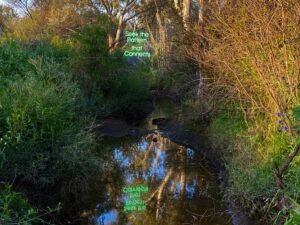
“Seek the Pattern that Connects” (For Gregory Bateson), 2022.
Curatorial Projects
In parallel with my work as an artist I have also initiated and co-curated a number of international exhibitions including Analogue: Pioneering Artists Video from the UK, Canada and Poland (1968-88), an international touring exhibition (London, Liverpool, Norwich, New York, Valletta, Toronto, Ottawa, Berlin and Warsaw: 2006-09), funded by Arts Council England, the Polish Cultural Institute and the Canada Council; The Digital Aesthetic (2001), Digital Aesthetic 2 (2007) and Digital Aesthetic 3 (2012), in collaboration with the Harris Museum, Preston; Analogue & Digital for the Fieldgate Gallery, London (2008), Yes Snow Show, (2008-09) at the British Film Institute, London and Light & Dark/Motion & Stasis at the Gooden Gallery, London, (2011)
Funding
My work has received funding from Arts Council of Great Britain, Greater London Arts, Arts Council England, Northwest Arts, Southwest Art, Southern Arts, the British Council, the Henry Moore Foundation, the UK Foundation for Sport and Art, the Ontario Ministry for Culture and the Arts, the London Arts Board and the Daiwa Foundation.
Writing
I have written and published articles, reviews, papers and book chapters about artists video and installation including A History of Video Art: the Development of Form and Function which was published by Berg (Oxford and New York) in 2006 and in Japanese by Sangensha (Tokyo) in 2013. An extended and updated 2nd edition of the book was published as “A History of Video Art” by Bloomsbury in 2014, and in Mandarin by The China Pictorial Publishing House, Beijing, 2018.
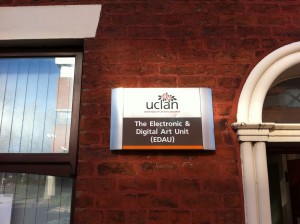
The Electronic & Digital Art Unit (EDAU) at the University of Central Lancashire
Teaching
I have taught video and film at a number of art schools and institutions including The London College of Printing, The London International Film School, Maidstone School of Art, Leicester Polytechnic, and the University of Central Lancashire (Uclan) where I taught from 1984-2012. Whilst working at Uclan I initiated and was head of Time-Based Media (1986-2000), co-founded the MA Fine Art course and established the Electronic & Digital Art Unit (EDAU) a centre for post-graduate research. I was made Reader in 2000, Professor in 2007 and Professor Emeritus on my retirement from teaching in 2012.
Some Additional Links with information on my work and activities:
